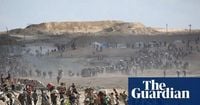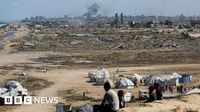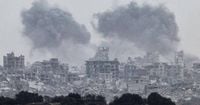As a new round of indirect talks between Israel and Hamas is set to begin in Egypt, the world’s attention is once again fixed on the Gaza Strip, where hopes for a ceasefire are rising—if only tentatively. The negotiations, scheduled to start Monday in the resort town of Sharm el-Sheikh, are built around a 20-point peace plan championed by U.S. President Donald Trump, whose administration has thrown its full diplomatic weight behind the effort. With both sides sending high-level delegations, and regional powers lending their support, the coming days may prove pivotal for a region battered by nearly two years of relentless conflict.
Hamas announced on Sunday that its delegation, led by Khalil al-Hayya, had arrived in Egypt to begin talks focused on establishing a ceasefire, ensuring the withdrawal of Israeli forces, and arranging a prisoner exchange. Israel, for its part, is sending a team led by top negotiator Ron Dermer, following Prime Minister Benjamin Netanyahu’s directive to engage in what could be decisive negotiations. According to Al Jazeera, Netanyahu expressed optimism late last week, saying he was hopeful a deal to release all remaining captives could be announced soon.
President Trump, who has made Middle East peace a central pillar of his foreign policy, took to social media Sunday to declare, “These talks have been very successful, and proceeding rapidly. The technical teams will again meet Monday, in Egypt, to work through and clarify the final details. I am told that the first phase should be completed this week, and I am asking everyone to MOVE FAST.” He later warned, “Time is of the essence or massive bloodshed will follow.”
Yet, even as diplomatic efforts intensify, the violence on the ground continues unabated. On October 5, Israeli forces struck Gaza, killing at least 24 Palestinians—including four asylum seekers near an aid distribution center north of Rafah, according to the Nasser Medical Complex. In the 24 hours leading up to midday Sunday, Gaza’s health ministry reported another 65 deaths from Israeli military operations. The bombing campaign has destroyed residential buildings in Gaza City and left plumes of smoke visible from the Israeli border, as reported by the BBC.
The toll of the conflict is staggering. Gaza’s Government Media Office reports that more than 2,700 families, comprising over 8,500 people, have been wiped off the civil registry in two years of fighting. Among the dead are at least 1,015 children under one year old, 1,670 medical staff, 254 journalists, and 140 civil defense rescue workers. Since the war began in October 2023, following a Hamas-led attack on southern Israel that killed about 1,200 people and resulted in 251 hostages, more than 67,000 Gazans have died in Israeli military operations, according to health ministry data.
Despite President Trump’s public call for Israel to “immediately stop the bombing” following Hamas’s response to the peace plan, Israeli air strikes and tank fire have continued. Israeli government spokesperson Shosh Bedrosian told reporters, “While certain bombings have actually stopped inside of the Gaza Strip, there’s no ceasefire in place at this point in time.” Prime Minister Netanyahu has ordered defensive fire if troops are threatened, and Defense Minister Israel Katz was quoted by Israeli media as saying, “Hamas will be disarmed, the Gaza Strip will be demilitarized, and the [Israeli army] will remain in controlling areas to protect the communities.”
The core of Trump’s 20-point plan revolves around an immediate end to fighting and the release of 48 hostages—only 20 of whom are believed to be alive—in exchange for the release of hundreds of detained Gazans. The plan also calls for Israel to pull back its forces to the so-called “yellow line,” its position in Gaza as of August 2025. However, the proposed withdrawal map would initially exclude nearly 900,000 Palestinians from returning to their homes, carving out significant portions of Rafah, Beit Hanoun, Beit Lahia, Gaza City, Khan Younis, and Deir al-Balah. Hamas had rejected a similar map in previous rounds of talks, but this time, the group’s response was notably less combative.
According to the BBC, many Palestinians were surprised by Hamas’s decision to enter the negotiations without its usual “red lines,” a move widely interpreted as a sign of external pressure from Qatari, Egyptian, and Turkish mediators. A senior Palestinian official familiar with the talks told the BBC that these mediators played a major role in convincing Hamas to tone down its objections and leave contentious issues—such as the fate of its weapons and Gaza’s post-war governance—for the negotiation table. Yet, this tactical flexibility is not without risk: every additional day of delay brings more death and displacement for Gazans, and many warn that Hamas’s limited leverage after years of war could force further concessions.
The international response has been cautiously optimistic. The foreign ministers of Egypt, Jordan, Indonesia, Pakistan, Qatar, Saudi Arabia, Turkiye, and the United Arab Emirates issued a joint statement Sunday welcoming Hamas’s steps and President Trump’s call for Israel to halt its bombing campaign. They also expressed appreciation for Trump’s “commitment to establishing peace in the region” and welcomed Hamas’s stated readiness to hand over Gaza’s administration to a transitional Palestinian committee of independent technocrats.
Senior Hamas official Izzat al-Risheq called the statement “an important support for efforts to end the war” and welcomed the “clear backing for the Palestinian position in the negotiations, [which] strengthens the chances of reaching a lasting ceasefire agreement.” He added, “We look forward to further Arab and Islamic support in order to stop the aggression and genocide being inflicted on our people in the Gaza Strip, leading to an end of the occupation and the realization of our Palestinian people’s aspirations to establish their independent state with Jerusalem as its capital.”
Trump has dispatched two close envoys—his son-in-law Jared Kushner and chief Middle East negotiator Steve Witkoff—to Egypt to help shepherd the talks. Qatari foreign minister Sheikh Mohammed bin Abdulrahman Al Thani is also expected to attend. The U.S. president has told Hamas that once it agrees to Israel’s initial military withdrawal line in Gaza, an immediate ceasefire would be triggered.
Yet, skepticism remains. Diana Buttu, a Palestinian human rights lawyer and former legal adviser to the Palestine Liberation Organization, told CNN that Trump’s plan “does not go far enough to ensure peace in the region.” Many Palestinians fear that the plan’s terms—especially regarding disarmament and the future role of Hamas in Gaza’s governance—leave too much unresolved. Trump, however, has maintained that “it’s a great deal for Israel, it’s a great deal for the entire Arab world, Muslim world, and world, so we’re very happy about it.”
As the delegations gather in Egypt, the world waits anxiously. With so much blood already spilled and so many lives upended, the stakes could not be higher. Whether these talks will finally break the cycle of violence in Gaza remains to be seen, but for now, there is at least a glimmer of hope that this bruised and battered region might be on the cusp of a fragile peace.






